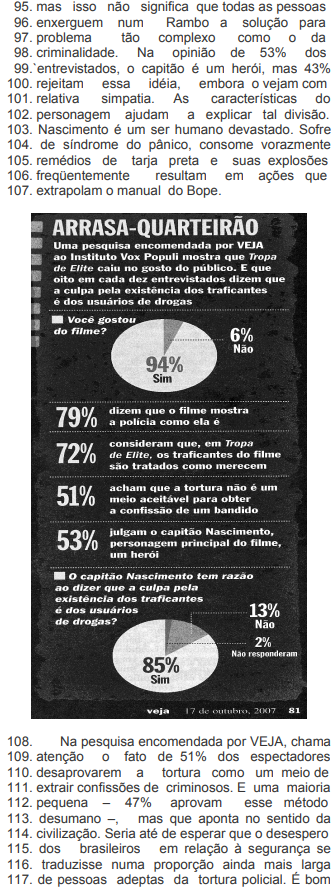Questões Militares
Nível médio
Foram encontradas 45.670 questões
Resolva questões gratuitamente!
Junte-se a mais de 4 milhões de concurseiros!
O texto acima se refere a algumas das transformações ocorridas na América Portuguesa, e principalmente no Grão-Pará, no chamado período pombalino.
Tomando como referência inicial esse texto, assinale a alternativa correta.




I - Os dados apresentados indicam que a maioria dos entrevistados julga que o filme retrata a verdadeira face da polícia, apesar de não gostarem do que viram pelo horror que descreve o filme. II - Menos da metade dos entrevistados não aceita os métodos utilizados pela polícia para obter confissões, apesar de julgarem que às vezes são necessárias as torturas. III - Entre a maioria dos entrevistados estão os que acreditam que a culpa pela existência do tráfico é dos usuários de droga. IV- Os dados descritos no gráfico apresentamse contraditórios.








“O tipo de conexão proporcionado por Tropa de Elite, do diretor José Padilha, é de outra ordem. Trata-se de um grande filme justamente pelo contrário: ele não concede válvula de escape ao retratar como a criminalidade degradou o país de alto a baixo”(L.10-15).
Assinale a alternativa correta referente a ESSE excerto.




I - No trecho “O pesadelo real ganha ainda mais nitidez” (L. 15-16), a caracterização do substantivo pesadelo permite entrever um paradoxo. II - A reportagem se refere ao filme como única forma de os brasileiros enxergarem a justiça se efetivando. III - Segundo a reportagem, bandido é tratado como bandido e mocinho é realmente mocinho. Tal aspecto retrata o enredo principal do filme. IV - O tema de Tropa de Elite, filme referido na reportagem, reflete a realidade do tráfico, reforçada pela impunidade e corrupção no Brasil.












I - O primeiro parágrafo intercala frases nominais e verbais. II - O fragmento “... que inundaram os camelôs de várias capitais...” (L.25 -26) apresenta uma linguagem de caráter conotativo. III - O que leva o filme Tropa de Elite a ser considerado um grande filme é a maneira arrebatadora que ele usa para fugir da realidade circundante.
De acordo com as idéias do 1º parágrafo, entre as proposições acima,




I - Só é considerada grande, a obra de arte que consegue interagir com as pessoas. II - Segundo Aristóteles, as tragédias representadas no teatro servem de alento para as tragédias da vida real. III - A catarse é uma válvula de escape para a vida das pessoas.




I - de sentimentos. II - próprios pesadelos. III - espectadores. IV - sentimentos de terror e compaixão.
É correto afirmar que entre as proposições acima,




“O assunto da obra do diretor José Padilha é a guerra diuturna que a polícia carioca move contra os traficantes de drogas encastelados nos morros favelizados da cidade”. Ao transformá-lo, sem alteração sintático-semântica, teremos:
1. Type O blood people must eat a lot of meat and avoid milk, yogurt and cheese, for example. 2. Type O blood appeared before the other blood types. 3. Type B diet, which is rich in yogurt, milk, cheese and meat, can cause diabetes. 4. People who want to slow the ageing process or fight cancer and diabetes should follow the blood type diet. 5. Type A blood people should eat many vegetables because this blood type is related to agriculture.
Which of the statements above are TRUE, according to Peter D’Adamo’s ideas?


As enzimas provenientes do intestino de peixe e do estômago de ave da Antártida são, respectivamente.
